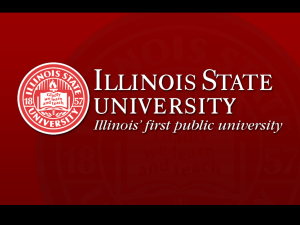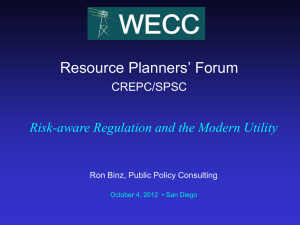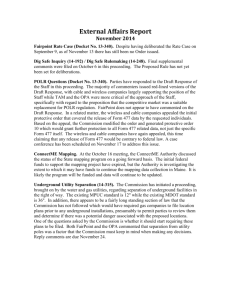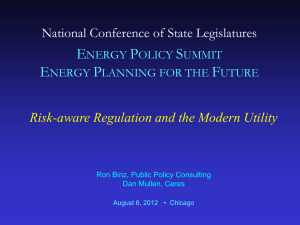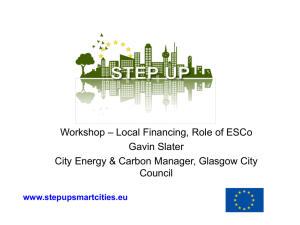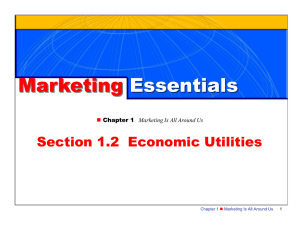straw proposal 2
advertisement
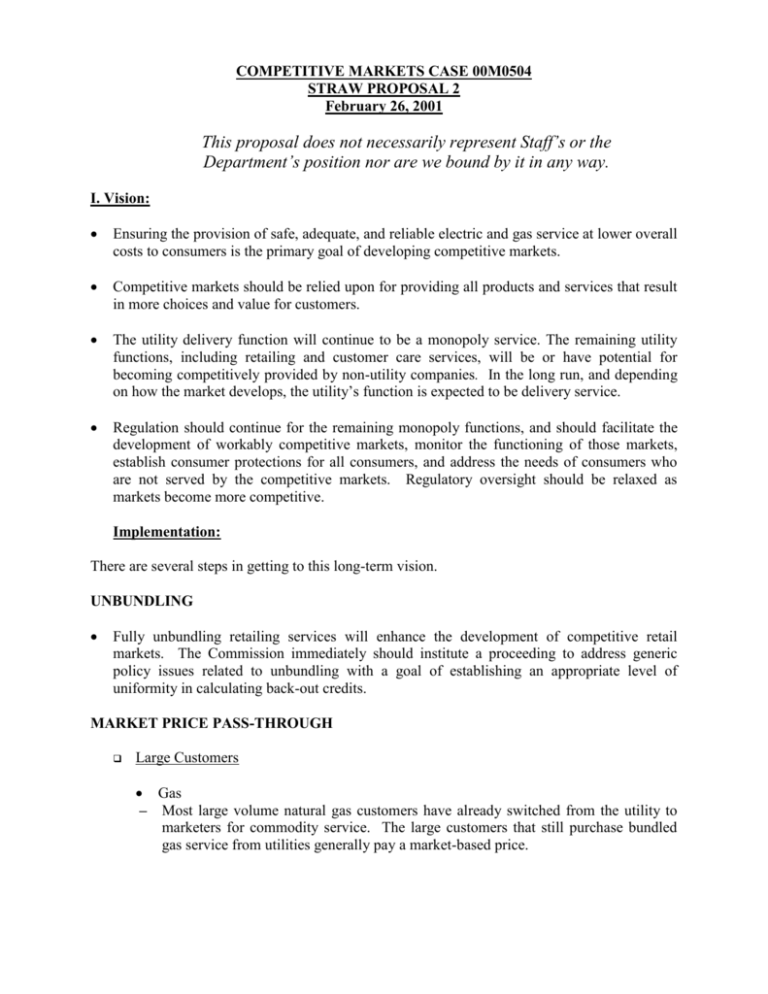
COMPETITIVE MARKETS CASE 00M0504 STRAW PROPOSAL 2 February 26, 2001 This proposal does not necessarily represent Staff’s or the Department’s position nor are we bound by it in any way. I. Vision: Ensuring the provision of safe, adequate, and reliable electric and gas service at lower overall costs to consumers is the primary goal of developing competitive markets. Competitive markets should be relied upon for providing all products and services that result in more choices and value for customers. The utility delivery function will continue to be a monopoly service. The remaining utility functions, including retailing and customer care services, will be or have potential for becoming competitively provided by non-utility companies. In the long run, and depending on how the market develops, the utility’s function is expected to be delivery service. Regulation should continue for the remaining monopoly functions, and should facilitate the development of workably competitive markets, monitor the functioning of those markets, establish consumer protections for all consumers, and address the needs of consumers who are not served by the competitive markets. Regulatory oversight should be relaxed as markets become more competitive. Implementation: There are several steps in getting to this long-term vision. UNBUNDLING Fully unbundling retailing services will enhance the development of competitive retail markets. The Commission immediately should institute a proceeding to address generic policy issues related to unbundling with a goal of establishing an appropriate level of uniformity in calculating back-out credits. MARKET PRICE PASS-THROUGH Large Customers Gas – Most large volume natural gas customers have already switched from the utility to marketers for commodity service. The large customers that still purchase bundled gas service from utilities generally pay a market-based price. - Electric Utilities should be required to offer their largest electric customers (i.e., those with interval metering) rate options reflecting the straight pass-through of hourly market electricity prices.1 In the long run, such pricing options will need to be coupled with appropriate customer outreach and education programs and further supported by market offerings to customers of load management and other price-responsive program packages that will enable customers to better manage their operations in a market-based pricing environment. Small Customers Gas – The Commission has already required gas utilities to take action to mitigate price volatility.2 Electric – A purchasing practices policy statement for electric utilities should be established, similar to that already in place for gas. – At this time, electric utilities should manage their supply portfolios to, among other things, reduce customer exposure to price volatility. This can be phased-out as the competitive market develops. – Once criteria (a) and (b) listed below under Preconditions, Timing/Process, have been met, utility rates that are more reflective of a straight pass-through of marketbased prices for commodity, capacity and other ancillary services should be extended to the incumbent’s smaller commercial and residential customers. Such utility pricing options will need to be coupled with appropriate customer outreach and education programs. UTILITIES EXIT COMMODITY FUNCTION (MODEL 2) ONCE PRECONDITIONS ARE MET – The most direct way to establish a robust competitive market is for utilities to cease buying and selling commodity (see the Commission's November 1998 Natural Gas Policy Statement wherein the Commission envisioned gas utilities exiting the merchant function in three to seven years). Electric and Gas utilities are expected to be out of the commodity function, i.e., buying and selling electricity and gas, for all customers. Before the complete exit, however, the Commission needs to be assured that the preconditions identified below have been met. These criteria may be satisfied at different times for gas and electricity and for large and small customers 1 See Case 00-E-2054, In the Matter of a Status Report on the Demand/Supply Component of the Department’s Electric price and Reliability Task Force Including Recommendations for Specific Utility Actions on the Demand-Side, Order Requiring Filings and Reports on Utility Demand Response programs (issued December 20, 2000). 2 See Case 97-G-0600, In the Matter of the Commission’s Request for Gas Distribution Companies to Reduce Gas Cost Volatility and Provide Alternative Pricing Mechanisms, Statement of Policy Regarding Gas Purchasing Practices (issued April 28, 1998). -2- PRECONDITIONS, TIMING, AND PROCESS Preconditions - Before utilities exit the merchant function the Commission needs to be assured that the following criteria have been met: (a) “Workably competitive wholesale markets” exist; (b) New York State registered ESCOs/marketers are collectively able and willing to provide reliable service to the appropriate market; (c) Mechanisms are in place to provide access to electric and gas service to all consumers who need service but are unable to secure it in the competitive markets (see POLR and Low-Income sections below); (d) There is general public acceptance of energy market restructuring and a reasonable expectation that greater levels of customer migration to competitive providers will create additional opportunities for all customers to save and to benefits; and (e) Potential legal impediments are addressed. Timing/Process - The timing for utilities to exit the commodity function will depend on how well the above conditions are satisfied. A multi-stakeholder “Competition Council” should be established to monitor the status of wholesale and retail competition, and to report to the Commission when the above criteria have been met. The specific measures to determine that these criteria have been met will be established with input from all parties. The following framework is suggested: within three months after an order in this proceeding - parties decide on metrics for determining when the above preconditions (a) - (e) have been achieved; twelve months after an order in this proceeding - review the status of the wholesale market to ensure that specific criteria are met; twenty-four months after an order in this proceeding - review the status of retail issues [pre-conditions (b), (c) and (d), above] to ensure that specific criteria are met; twenty-five to forty-eight months after an order in this proceeding (assuming that the 12 and 24 month reviews were successful) conduct a coordinated statewide outreach campaign educating customers that the utility is exiting the commodity business, coordinated outreach could be conducted sooner to educate consumers on other emerging competitive issues, depending on the need; Forty-eight months after an order in this proceeding - utilities are expected to exit the commodity business. UTILITIES EXITING RETAIL FUNCTIONS (MODEL3) The opening of some retail functions (billing and electric metering) to competitive markets is currently in progress. Before the utilities cease providing retailing functions (Model 3), however, the Commission must be assured that competing ESCOs/marketers have the infrastructure to provide the retail services. This issue should be revisited within the next few years to assess the ability of the marketplace to provide these services. However, individual utilities should not be precluded from voluntarily seeking to exit the retail function sooner, as long as there is a showing that the marketplace is ready and capable of providing these services (some of the yard sticks to gauge whether the marketplace is ready might -3- include percentage of customer/load migration experienced to date, number of ESCO/marketer choices available to serve customers, customer satisfaction with ESCOs/marketers, collective ESCO/marketer infrastructure in place to handle retail functions for millions of consumers). II. Consumer Protections: Development and implementation, including enforcement, of modified consumer protection rules appropriate to meeting the needs of consumers in a competitive marketplace is essential for the well-being of all New Yorkers. Changes may be needed to HEFPA and NonResidential rules, and the modified rules should be aligned with other existing statutory requirements. All service providers in New York are expected to abide by a standard basic level of consumer protection rules. The parties should develop these standard rules. Specific areas to be considered include disclosure requirements, service quality standards, fair trade practices (e.g., anti-slamming, anti-redlining), and complaint resolution. More consumer protections may be needed during the transition phase (e.g., limitations on prepayments, marketing codes of conduct). Experience would allow for the refinement and modification of those protections, to achieve an appropriate balance between the strengthening of consumer trust that they create, and the costs they impose on marketplace participants. Once there is a vibrant competitive retail market, some of the protections may be relaxed. The Commission should investigate and resolve customer complaints against ESCOs. This could be accomplished through alternative dispute resolution and other mediation techniques. III. Customer Migration Strategy: Ideally, full customer migration to competitors should happen voluntarily. This has occurred for large gas customers and may in fact occur for large electric customers. Voluntary migration should and will be strongly promoted through customer education and customer choice. ESCO/marketer price mechanisms and value-added services should give consumers new options over current utility offerings. In addition, utility price signals (e.g., utility recovery of some stranded costs via commodity charges) could also help facilitate customer migration. IV. Provider of Last Resort: The POLR entity or entities will have the responsibility of satisfying “obligation to serve” and attendant consumer protections. As long as the utilities provide commodity service to some classes of customers, they will continue to be the POLR for commodity service to customers in those classes. During the transition, however, utilities should be encouraged to outsource POLR functions (i.e. implement POLR pilots). Once the utilities fully exit the commodity function, other entities will discharge this responsibility. The POLR entity could be different for electric and gas industries and different by customer group, and should be approved by the Commission. The utilities may also bid for providing POLR service. The preferred approach is the one where one or more entities provide POLR service on a regional or statewide basis, with the “obligation to serve” not imposed on all ESCOs. It is expected -4- that in the end-state, the POLR will serve “transient or gap” customers only, and not necessarily have a large customer base. A pre-requisite for establishing the new POLR entity or entities is the continuity of the obligation to serve. Reliability must be ensured. The solution must address the term of obligation and what will happen if one or more entities are unable to fulfill POLR obligations during, or at the end of, the term. With regard to POLR pricing to consumers, price offerings could include both fixed and variable prices as options. The variable price could be formula-based, approved by the Commission. Assuming all ESCOs do not have the obligation to serve, a competitive process involving issuance of an RFP should be used to select the POLR entities. The term should be at least a one-year period with possible provision for extensions to two or three years. Bidders should be able to bid across utility territories, by fuel type and/or service class, to allow serving multiple areas or the entire state. Evaluation of RFPs must consider the technical and financial competence of the bidders and terms of the proposed service offerings. Renewable energy sources could also be considered in the selection process. A process is needed to provide guidance on how, if at all, the terms could be changed during the term. If suitable bidders are not found, the PSC can designate an entity (a governmental body, NYPA, incumbent utility, etc.) as the POLR or solicit a qualified bidder under negotiated terms. An interim POLR could be designated by the PSC in case of default. POLR oversight is expected to involve pricing, service quality, consumer protections, economic viability and a process for back up in the event of POLR failure. This will require the collection of data regarding complaints and other compliance measures. It will also involve a process for monitoring and problem resolution, as well as provision for enforcement and disqualification as conditions and qualifications may change over time. Some limited number of service standards (addressing reliability, safety etc.) should be developed that qualifying bidders would be subject to. A publicly available report card on POLR performance is recommended and should be periodically issued by the Commission. POLR oversight role should be expanded to include other stakeholders besides the PSC (e.g., consumer groups and other representatives of the community) on a voluntary basis in an advisory role, working with Department staff, subject to the Commission's decision making authority. V. Low Income Programs: The energy burden on low-income customers should not be worsened as a result of the development of competitive markets. The continuing needs of low-income customers both in the end-state and during the transition to the end-state must be addressed through low-income programs and other initiatives. Appropriate funding resources should be assured to address the needs of low-income consumers. Market-based solutions, where possible, should be developed to address the needs of lowincome customers. -5- In the long run, the financial support needed to assist low-income customers should be derived from broad-based public funding. For the transitional period, however, surcharges on bottleneck functions (e.g., pipes and wires) would be a reasonable alternative mechanism for achieving these benefits, the loss of which would not be in the public interest. Such cost recovery mechanisms are reasonable because low income programs help to at least partially avoid collection related and working capital costs on unpaid bills that are borne by all customers, as well as collateral costs to government social service agencies. A basic level of reasonably affordable service must be maintained for low-income customers. Coordinated program initiatives that include programs implemented by utilities as well as alternative providers should be developed. The sources of program funding should be considered in program design and implementation. Some of the components to be considered part of a coordinated statewide low-income program could include the following: Targeted energy efficiency and weatherization measures - to reduce usage and overall energy costs for payment-troubled low-income consumers and address the concern that low-income households tend to live in poorly maintained housing stock. Energy education and budget counseling programs - to help customers manage energy affordability problems. Forgiveness of arrears linked to improved prospective payment behavior - to improve revenues from low-income customers. A “lifeline” discounted rate (without distorting economic price signals) - to reduce energy burden. Such a discount should be applied to delivery rates, in order to maintain customer entitlement whether the customer stays with the utility for sales service or migrates to a competitive supplier. Market-based solutions, such as aggregation programs - that allow low-income customers an opportunity to enjoy the benefits of a competitive market, as well as providing a savings to counties, municipalities, or other entities that seek to aggregate low income customer load. Reducing overall energy rates to achieve lower consumer prices and funding low-income programs through energy delivery rates are competing goals that need to be continually reconciled. The future sources of funding for low-income programs need to be examined on an on-going basis. VI. Public Benefit Programs: A competitive market may not necessarily provide all energy efficiency, renewables and R&D programs that are in the public interest because demand for these activities in a competitive market is driven by the benefits derived by the purchaser rather than the benefits to society as a whole. These programs provide important environmental benefits that are difficult to obtain through markets. Ideally, the financial support needed for these programs should be derived from broad-based public funding. Energy Efficiency/Renewables/R&D programs (fuel-neutral) could be funded from a competitively neutral Public Benefits Charge assessed on all electric delivery rate customers until the market meets the societal needs that the programs are designed to address or broad based funding approaches can be implemented. -6- Such energy efficiency/renewables/ R&D programs could be implemented by a single entity to be designated by the Commission (e.g., New York State Energy Research and Development Authority) as program administrator. A multi-stakeholder forum could be established to assist with defining needs and objectives, setting fund requirements, reviewing compliance and other standards for participation, as well as periodically assessing whether the market is meeting the societal needs that the program is designed to address. The Public Service Commission will administer a process that will aid in its determination of the amount and oversight of the collection of the funds as part of its regulation of the T&D companies. Gas customers should continue to fund utility-based R&D as per existing Commission orders.3 VII. Aggregation: We expect that clarity and commonality in language will facilitate the transition to competition. As a first step, we offer the following definitions. Once consensus is reached on definitions, the parties should develop necessary business practices and list requirements for new entities. Aggregator means any person or firm joining two or more customers into a single purchasing unit to negotiate the purchase of electricity and/or natural gas from ESCO/marketers. Aggregators may not sell or take title to electricity or natural gas. ESCO/marketers are not aggregators. Broker means a firm that acts as an agent or “middle man” in the sale and purchase of electricity or natural gas in the wholesale market, but never owns the electricity or gas. ESCO means an entity that can perform energy and customer service functions in any competitive environment, including buying and reselling of electricity and natural gas and assistance in the efficiency of its use. [modifications from the PSC definition] Marketer means an entity that can perform energy and customer service functions in any competitive environment, including buying and reselling of electricity and natural gas and assistance in the efficiency of its use. Registered Aggregator means any non-profit, public interest organization, governmental entity or private firm that provides one or more of the following: conducts outreach and education to small use customers; acts as procurement agent for targeted end-users, negotiating pricing, terms and conditions with ESCO/marketers and offers the package to the customers; renders bills on behalf of the ESCO/marketer; and maintains on-going 3 Case 99-G-1369, Petition of New York Gas Group for Permission to Establish a Voluntary State Funding Mechanism to Support Medium and Long Term Gas Research and Development (R&D) Programs, Untitled Order (issued February 14, 2000). -7- customer service relationships with the aggregated customers. Registration with the PSC is voluntary. The PSC Web site will list registered aggregators. Restricted ESCO/marketer means a firm or governmental entity that takes title to electricity or natural gas on behalf of two or more service end points (defined customers or for its own use), which are defined when registering with the Department of Public Service such that others are precluded from joining or participating. Restricted ESCO/marketers are not listed on the PSC Web site. Sales Agents means a separate person or firm that matches buyers and retail sellers of electricity or gas, playing no role beyond customer acquisition. We expect the marketplace will provide consumer information about ESCO offerings and performance of ESCOs and aggregators in an unbiased manner. Access to information on ESCO/marketer offerings also will continue to be provided on the PSC Web Site. VIII. Additional Transition Measures: Uniformity in ESCO, customer, utility business interaction practices should continue to be pursued, i.e., continue to improve the UBP. Any economic development or flex rates offered by incumbent utilities to large customers in the future should be competitively neutral, should cover the incumbent’s marginal cost plus a contribution to fixed costs and preferably should be administered as discounts to standard delivery service rates. -8-
